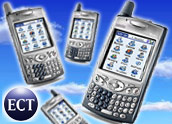
Part 1 of this two-part series examines some of the mobile devices that are optimized for enterprise applications. Part 2 explores what else is out there.
Device makers are hard at it trying to crack the market for mobile enterprise software applications. While BlackBerry devices put Research In Motion in a front-running position, enterprise users have an increasingly wide range of choices when it comes to high-end smartphones and mobile devices.
Recent enhancements and lower prices continue to fuel buzz about Apple’s iPhone in the enterprise, but Nokia, Motorola and Sony Ericsson, as well as RIM, continue to develop closer ties with enterprise software vendors and telecom carriers as they compete for their share of a market expected to grow strongly.
Vendors and device manufacturers, as well as carriers, are zooming in on developing modular mobile versions of flagship enterprise applications, including business intelligence (BI), customer relationship management (CRM) and enterprise resource planning (ERP) for specific classes of enterprise end users.
BlackBerry and Challengers
RIM’s BlackBerry is Forrester Research principal analyst Peter Marston’s top pick when it comes to mobile devices that support enterprise applications, ranking devices based on Windows Mobile and Palm platforms second and third, respectively. Ease of use, versatility and cost work in BlackBerry’s favor when it comes to comparisons between devices and operating systems, he told CRM Buyer.
“The reason for my ranking is that BlackBerry had much success with creating a device for extended e-mail to mobile devices, and as a result of organizations rolling out e-mail as the first ‘real’ enterprise app businesses wanted to leverage their hardware investment and broaden the BlackBerry device’s extensibility, as well as minimize management for multiple devices.”
iPhone Enterprise Potential
Marston sees Apple’s iPhone generating more buzz, driven by two changes made since its initial roll-out last year: lowering its price and building in the ability to link to Microsoft Exchange.
“Its browser interface is very strong. The cost of the solution has grown more favorable, but US$400 for the initial device, compared to BlackBerry devices, was a huge impediment. Its new price should be more favorable for greater adoption within the enterprise, but I believe Apple lost some potential customers due to its initial high costs of procurement. The result? Buyers turned to BlackBerries.”
Lacking synchronization with MS Exchange “drastically impeded penetration as sales resources that had iPhones for personal use couldn’t consolidate tasks to one device,” he added. “They still had to use their BlackBerries. So until recently, Apple’s iPhone faced a major hurdle as resources who wanted to port over their iPhone to support business activities had to depend on two devices to handle calls and e-mails. Now, though, the product supports exchange, so it’s possible iPhone will gain some traction — but Apple isn’t known for running enterprise business applications. We’ll see how that changes.”
Beyond RIM, Apple
There’s a lot more out there beyond the BlackBerry and iPhone when it comes to smartphones with enterprise application capabilities, however. Which device is best varies depending on the vertical industry — and even departments in which the apps are being deployed — Scott Lane, Sprint’s director of business development and applications, told CRM Buyer.
“The BlackBerry devices are just a few of many devices that support business mobile apps. Sprint has a wide range of solutions that can address our customers’ needs, regardless of the device they are carrying. Most smartphones can support a variety of business mobile apps. And most devices are compatible with GPS-based business applications, including several rugged devices that are well suited for tough business environments.”
Customers are seeking high-speed access virtually anytime, anywhere, as well as solutions that can deliver a high return on investment, he continued. “Most of the solutions that have been successful outside of e-mail are the more blue-collar industry solutions, like those focused on fleet management and field services.
“It is about more than just tracking, though that is a popular feature. These solutions change how companies conduct business and manage their mobile employees, including reducing paperwork by sending work orders and other critical documents directly to the phone, getting real-time accurate time sheet reporting where mobile workers clock-in and clock-out on the phone and saving fuels costs by optimizing delivery routes, to name a few.”
Mobile Enterprise Apps Go Native
Oracle’s doing it, Salesforce.com’s doing it, even Pentaho’s doing it — and so is SAP. Looking to do more than simply develop scaled-down versions of their flagship enterprise applications, vendors are working more closely with leading device manufacturers and telecom carriers to develop native versions of their flagship applications for mobile platforms customized for use by different types of enterprise users.
SAP and RIM in May announced that they were joining forces by jointly developing “anytime, anywhere mobile access” to SAP’s enterprise applications through the BlackBerry platform. The first fruit of that partnership will soon come to market: a native BlackBerry smartphone client that merges SAP CRM with the core functions of the BlackBerry platform, including its e-mail, address book and calendar applications.
Developing native BlackBerry client apps enhances performance, automates data synchronization and simplifies deployment and maintenance tasks. It also enables SAP to leverage two of the BlackBerry platform’s greatest strengths when it comes to enterprise use: mobile data security and reliable, push technology-based data delivery.
A Long, Winding Road
SAP has been porting its applications to mobile platforms for more than five years now, recounted Vinay Iyer, vice president, SAP CRM global marketing and mobility solutions. Starting down the co-development path with RIM, they reviewed approaches enterprise software vendors and device manufacturers had taken to develop mobile versions of their projects.
“We started with the fact that most vendors’ approach was to bring in a mobile front-end and build synchronization between the device and enterprise platforms. And in the past, they also offered to provide browser-based access. Basically, they built an integrated, lightweight version and mobile device interface, as well as synchronize interaction with e-mail, voice calls and the CRM system.
“The problem with those approaches: one is that from a user perspective, it’s rather painful to learn how the mobile CRM app works on their device — usually a different navigation paradigm was involved — and then you had to remember to keep things synchronized. From an application management perspective it’s also quite painful: IT has to manage another version of the application for each device, for many different models with unique features, so the cost of administration for IT managers isn’t trivial; it’s pretty significant.”
Moreover, software vendors typically have to build backward compatibility when they upgrade enterprise apps, and that’s a burden on the vendors, especially in the mobile space with its profusion of different platforms and devices, he added.
BlackBerry’s Edge
“We realized the limitations of this approach and in 2004, when our partnership with RIM began, we sat down with them and said, ‘Hey, BlackBerry is now the de facto platform for mobile enterprise users. How can we make it easier for end users and IT managers and staff, and also off-load some of the burden on SAP developers and software staff?'”
They decided the best way to do that was to co-develop a native BlackBerry-SAP CRM application. “We leveraged the capabilities of RIM’s push and synchronization technology so that data and communications automatically gets pushed to the user, similar to the solution they came up with e-mail synchronization,” Iyer explained
The BlackBerry platform has unique advantages when it comes to accessing and interacting with enterprise data and networks, Iyer added. “Unlike other mobile device manufacturers who access enterprise data through their mobile Internet networks, BlackBerry has taken the approach of installing BlackBerry enterprise servers within firewalls that gives them access to internal enterprise systems.”
BlackBerry enterprise servers in turn talk to BlackBerry’s network data center, relying on proprietary messaging formats and protocols so that BlackBerry, as well as international carriers it works with, can guarantee secure delivery of any piece of information.
What’s in Store?
Having taken a first big step toward developing native SAP CRM applications for the BlackBerry platform, the partners are moving on with phase one plans that enable sales force automation.
“We’re looking at report and analysis distribution features as well as workforce management. There’s a lot of ideas in the works, but we plan on tackling the most common problems first. They’ll be a natural extension of native capabilities on the device and we’ll just add on more features and capabilities over time,” Iyer told CRM Buyer.
“We are still talking about a smaller device with limited capacity, but not when it comes to key features and functions relevant to an end user, like quota planning, competitive analysis, as well as others for salespeople and field service staff.”




















































The ability to stream live video from handset to handset, or handset to computer, or stationary camera to handset or computer is the safety, security, law enforcement future. Better software for devices is leading up to some of the most advanced surveillance abilities ever. Reality Mobile (www.realitymobile.com) is using streaming video now, and I can’t wait to see what comes from the competition in the future. I’ve never seen anything like it.